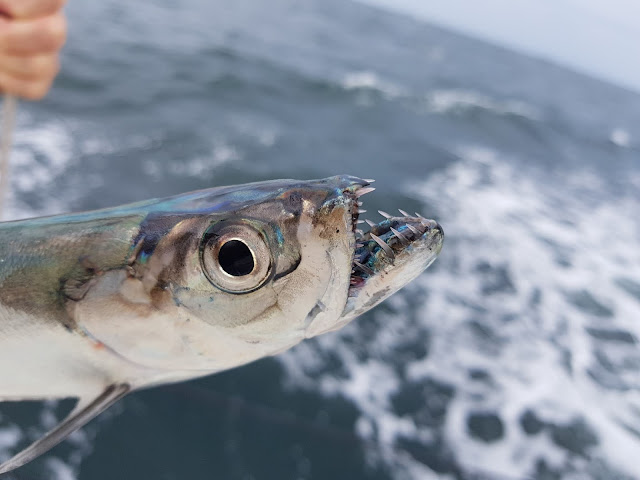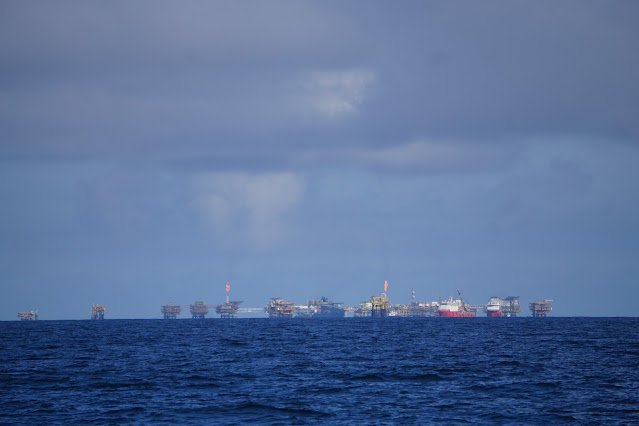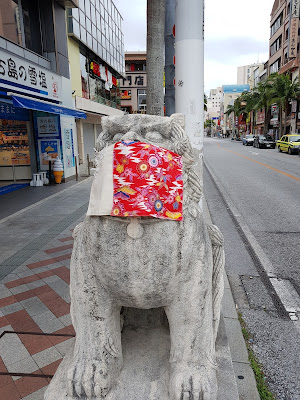Irene Undertakes a Long Upwind Slog, Singapore to Okinawa
Goodbye Singapore, Thank You For the Shelter
In our last post, Irene had arrived in Singapore after being turned away by Indonesia (after a long direct voyage from Turkey.) In Singapore we picked up a mooring buoy in front of Changi Sailing Club, where we passed the next 127 days waiting for either a change in policy allowing us ashore in Singapore, Malaysia, Thailand, or Indonesia or the change in season that would allow us to continue on our journey home to Seattle. Those changes in policy never materialized in any practical sense, so we counted the days, watched the weather and planned our escape.
 |
| Paint test float Changi |
While in Singapore we developed a pleasant shipboard routine on our mooring at Changi. On most Friday evenings we would share a dinner with Carolyn and Fatty, sometimes with some of their local friends, aboard Irene or Ganesh. We shared enjoyable days with our neighbor Adamastor, a young English couple with three wonderful children. Every other week we dropped our mooring and motored to the club’s pontoon for a couple of hours, where we refilled our water tanks. Irene’s bottom was growing foul at a spectacular rate and we made a point of scraping it weekly if possible, only interrupted by excess current caused by heavy rains or spring tides. We learned that marine growth was so severe in this area that many major antifouling manufacturers maintain test floats of panels painted with experimental paint just at the edge of our mooring field.
 |
| Slipway Changi |
Changi sailing club has a small slipway that members use to repaint bottoms. Bigger vessels like ours used other facilities, none of which were allowed in our state of isolation.
 |
| Departing Changi |
Edwin, the General Manager of CSC and our gracious host for 127 days, and Carolyn and Fatty came to the float to wish us Bon Voyage
Still, as comfortable as we were, it was definitely time to leave, after 127 days for goodness sake! On February 2, 2021 we departed directly for Japan. Countries on our path – Indonesia, Brunei, Malaysia and the Philippines – all remained closed to us, so it was to be another long nonstop passage. Spirits were high as we topped off water and said our goodbyes.
 |
| Singapore departing formalities |
Peter is more than ready to complete exit formalities with the Singapore customs launch
 |
| Arrr a visitor |
This guy jumped aboard as we sailed away from Singapore
We strapped in the sheets tight and a brisk wind blew as we flew across the shipping lanes and out to sea. Intoxicated with freedom, we marveled at the sights and motion and noise as Irene charged on, tossing spray high into the air. One of our jib sheets parted with a bang, and we struggled to roll up our flogging sail. Before setting out on a long passage always prefer to do a few short sails to test equipment that has been disused for a long time, say 127 tropical days, and to have time to fix any issues we find in calm water with supplies available. One more luxury not available in COVID times.
 |
| Yankee sheet safety |
Thankfully we were able to knot the break in the sheet and then sail three days, all the way to Borneo, without tacking at all. There our brisk breeze became weak and then downright feeble. We sailed slowly past muddy river mouths and dystopian looking oil rigs. When the wind completely died, we fired up the diesel, consuming a bit of the precious fluid so heavily extracted in this region. Our breeze came and went, and clocked around to a direction requiring the first few tacks of the passage.
 |
| Baram River Brunei |
Brown river water doesn’t mix with clear salt water
 |
| Brunei oil city |
A root cause of climate change
At the north end of Borneo we encountered full on NE monsoon on the nose, and as a result we really struggled to get across the channel to the Philippine island of Palawan. This area is a high risk zone for piracy, and we were a bit nervous as we tacked north. We wanted to stay out of sight of land yet not stray into the Spratly Islands to the west of us – a high risk zone for encountering unfriendly Chinese military vessels. To up the ante a bit more, charting is not considered reliable here. But the wind blew steadily and soon we were past pirate and gunboat zones. Morale improved onboard. And then wind direction lifted and we were able to fly NW on one glorious port tack almost to the north end of Palawan. Morale improved even further. Then of course the wind headed us, tacking resumed, and we hammered onward. Even so, morale remained high.
 |
| Deck harvest |
Big and small flying fish, both make a delicious breakfast
 |
| North Palawan sunny skies |
 |
| N. Palawan view Phillipines |
 |
| tacking light wind N Palawan |
 |
| becalmed N Palawan |
 |
| Hot hot hot weather, salt water cool off |
The wind became light, and one hot day we arranged for some salt water bathing on deck. Fresh water was a concern on this passage. Our watermaker has been nonfunctional for quite some time, so we must rely only on our tanks of about 200 gallons. Of course, we augment with rain water when we possible but we had no real rain on this passage until we reached Okinawa. We carry some emergency water containers in the bilge, too, but have never had to use them. Our conservation measures worked well enough and we arrived with 50 gallons of Singapore water to spare.
 |
| Sailing to windward |
 |
| Off Mamburao River, Mindoro Isl PH |
We received an email from our longtime friend, sailor and stormwatcher Mike Scott of Orcas Island in Washington State giving us a heads up. A tropical storm, Dujuan, was developing and forecast to track in our direction. What?? This time of year is statistically the absolutely the lowest for risk of tropical storms. Sigh. We made a plan to keep moving to an area of shelter on the lee of Mindoro Island.
Irene was getting slow and sluggish – tacking was difficult. We could see bunches of grass on the waterline, and a remora had taken up residence on our rudder. During the night, for the first time ever, Irene missed stays. In an area thick with small fishing boats that often show no lights until they decide you pose a danger, we needed to tack quickly to avoid a small vessel. Of course, this was the time Irene chose to balk. We managed, but on the spot we resolved that if we needed to stop and seek shelter because of a tropical storm that we would make a point of diving in and scraping our foul bottom.
 |
| Mamburao view PH |
 |
| Scraping grass at Mamburao |
 |
| TS Dujuan (JP)/Severe TS Auring (PH) |
 |
| Mamburao neighbors |
 |
| Cockpit drain aquarium |
It became obvious that the center of TS Dujuan was forecast to pass directly over us so we chose a likely spot to hunker down – river mud and mangroves to give good protection and anchor holding and enough distance from habitation to keep our “right of innocent passage” status clear. We dropped the hook in the afternoon and commenced with scraping operations early the next morning. Forty hours later our bottom was as clean as we could get it and TS Dujuan had deteriorated to a heavy rain event without much wind. So we resumed our trek, and Irene sailed much faster and steered much, much better.
 |
| Handing off a snack |
 |
| West Luzon fishermen |
 |
| Sailing into the sunset NW Luzon |
 |
| NW Luzon FAD |
 |
| FAD fishboat |
We enjoyed seeing and at times interacting (trading snacks for fish) with fishing boats along the Philippine coast during the day, but at night it was another story. The small and low boats were absolutely invisible on radar in any sort of wind, and fleets of them were thick in places. Also hard to see by eye and invisible by radar were very heavy duty FADs (unmanned Fish Attracting Devices) that could not be expected to show a light. We developed the habit of sailing (when we could) more offshore at night in the merchant ship lanes where AIS and bright navigation lights made collision avoidance more simple. One more comment about our day/night routines – at night we really resist motoring, because there is no chance of spotting floating debris that could be caught in the prop. We’ve seen all sorts of stuff -line, lumber, vegetation, pot warps, plastic, and cloth, any of which could dent or wrap our max prop.
 |
| NE Luzon Palaui Isl |
As we approached the top end of Luzon we hatched a plan to use some of our remaining fuel to motor (a calm was forecast) to the most eastward point in order to depart the island poised to deal with west setting current. There we anchored overnight to wait for wind, and headed out the next morning.
 |
| Boat flag San Vicente PH |
 |
| San Vicenet PH from anchorages |
We sailed north in good wind, but were swept to the west by strong currents. Irene seemed intent on visiting Taiwan, but we knew that country would not welcome us because of COVID. Once clear of the last of the Philippine islands we were able to head directly for Iriomote Shima, one of the more southerly Japanese islands. There we got permission via email from the Japanese Coast Guard to shelter in the lee of the island for the duration of a short fierce northerly that was forecast. Not allowed to anchor, we dodged back and forth under power (Alaska style) for a long windy night. As tedious as it was, we were grateful to not be blown halfway back to the Philippines. The next morning we headed on north west, Okinawa or bust!
 |
| Weather change |
 |
| Stormy day (Off Iriomoteshima) |
We were a bit low on diesel now and worried about the weather forecast, which suggested that if we didn’t reach our port of Naha on Okinawa in the next three days that we would be prevented from doing so for another day or two by more northerlies. Which would make us late for our arrival appointment with the Port, Customs, Immigration, Quarantine, and Coastguard. We had been warned that it was absolutely unacceptable to be late. So as we approached Naha three days early for our appointment, we sincerely hoped that early would be acceptable. And so it turned out to be, all departments concerned adapted gracefully to the change in schedule. Our formalities were thorough and polite, and we were accepted into the country. We were very grateful to be docked in the first country to accept us ashore since departing Turkey 233 days earlier.
Hello Japan,
Thank You For Allowing Us Ashore!
 |
| Naha arrival Japan |
Our passage had taken 31 days, we had sailed 3001 nautical miles to accomplish a 2020 nautical mile passage. Those extra miles had been racked up by the inefficiencies of tacking and leeway. There are reasons that gentlemen don’t sail to weather, and this is one of them. Some others? The motion and noise of slamming into waves is not pleasant, some of the almost constant water on deck (from those waves) inevitably finds its way down below, cooking at extreme angles of heel isn’t easy or sometimes safe or even possible, and repetitious cranking of sheet winches has taken its toll on Peter’s shoulders. Progress is slow and the workload is high. If the wind is strong, both of us must be on deck to handle sheets. Nevertheless, our tiny crew of two took it all in stride and we arrived in good spirits and good health. But it non-COVID times we can’t imagine taking on such a passage.
Reflecting on our passage as a whole, in some ways because of COVID it was more similar to days long past than recent yacht passages. We were reminded of historical times as we worried about pirates and hostile military, and passed villages and shorelines where we could not land, all forbidden to us. In these times any interplay with shore is fraught with tension. Friend or foe? Also, as we struggled with bottom growth we remembered stories of square riggers tacking and tacking day after day yet unable to make progress.
 |
| Masked Okinawan Shisha |
 |
| Crab park Naha, Okinawa |
We walked on wobbly legs around Naha. The art is impressive, from giant crabs to manhole covers. The climate is wonderful and we passed the weekend absorbing new sight and sounds. Irene moved around to the other side of the island to serve our fourteen day quarantine.
 |
| Pedestrian roundabout Naha |
 |
| Naha street art garden elf |
 |
| Naha street art bridge dragon |
 |
| Naha street art Ryuchu |
 |
| Naha street art You3 entrance |
 |
| Okinawa buoy |
 |
| Pandanus Screwpine/Okinawan Adan |
 |
| Park entrance Shisa |
The Yonabaru Marina has capability to haul, and we eagerly made an appointment with the lift. As you can imagine getting new antifoul paint on Irene’s bottom was a priority for us.
 |
| Yonabaru Marina trailer |
Peter is a bit dubious of the trailer...
 |
| Yonabaru lift Okinawa |
 |
| Yonabaru slings |
Irene’s bottom in very unlovely condition
 |
| Yonabaru hoist weight |
A clear and accurate readout of the weight at each lift point and total, for all to see
The powerful and precise lift was very impressive. It sang a cheerful little song as it worked. We slapped on a coat of paint with the help of able and lovely assistant A kiko, and splashed in record time.
 |
| Yonabaru restaurant |
Yes, we are in Japan!
Our first impressions of Japan are very positive. We were a bit nervous at first – COVID times and entry formalities had already proved harsh to us in the recent past, and we had heard of cruisers having various difficulties on arrival, but our experience turned out to be very good. We have already found some familiar and delightful things – buoyage is thorough and “red, right returning,” the food is delicious and familiar to us Seattleites, the climate here reminds us of Hawaii. Our plan, over the next couple of months, is to make our way up the west coast of Japan to the northernmost island of Hokkaido. There, as our visa expires, we will depart the country and head for Alaska.

Comments
Post a Comment